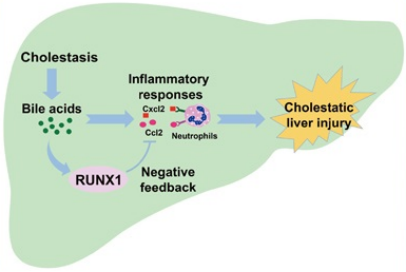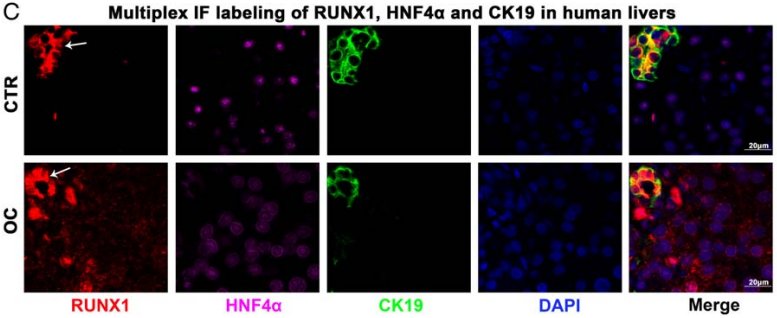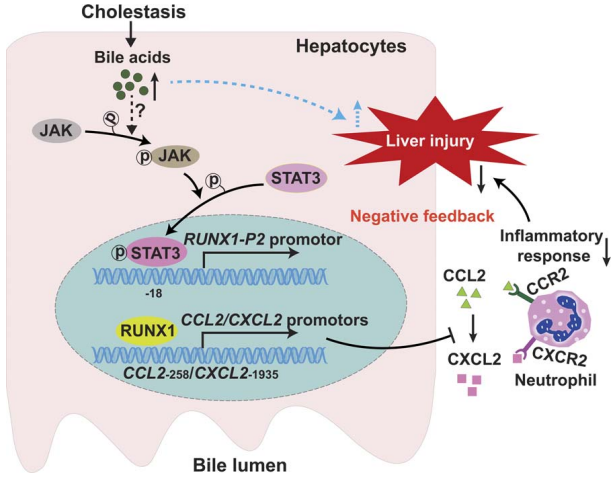- Cart 0
- English
mIHC Literature Interpretation: Comorbidity of the Liver and Gallbladder - Cholestatic Hepatitis
Ancient sayings go, "The liver and gallbladder shine upon each other, sharing honor and disgrace." In the biological body, the liver and gallbladder are also a pair of organs that "share honor and disgrace." These two organs are adjacent in position, and if one encounters a problem, the other is often not spared.
In the digestive system, the liver is in charge of detoxification and secretes bile; the gallbladder, attached to the liver, functions to store and excrete bile. When there is an obstruction in the secretion and excretion of bile, it leads to cholestatic disease, causing damage to liver cells and the body. In the later stages of the disease, it may lead to liver fibrosis, cirrhosis, and ultimately liver failure.
In September 2021, Professor Chai Jin's team from the Southwest Hospital of the Army Medical University published an article titled "A homozygous R148W mutation in Semaphorin 7A causes progressive familial intrahepatic cholestasis" in the EMBO Molecular Medicine journal (IF: 12.137). The article proposed that a homozygous R148W mutation in SEMA7A (Semaphorin 7A) leads to progressive familial intrahepatic cholestasis (PFIC).
In January of this year, Professor Chai Jin's team published an article titled "Runt-related transcription factor-1 ameliorates bile acid-induced hepatic inflammation in cholestasis through JAK/STAT3 signaling" in the HEPATOLOGY journal (IF: 17.298). The article continues to focus on the study of cholestasis, aiming to investigate the role and mechanism of the RUNX1 gene in bile acid-induced hepatic inflammation associated with cholestasis.

RUNX1 is a key transcription factor involved in the regulation of gene expression during embryonic development, hematopoiesis, angiogenesis, tumorigenesis, immune responses, and particularly, inflammatory responses. After re-analyzing single-cell RNA sequencing (scRNA-seq) data from human livers, the research team found that RUNX1 is widely expressed in all hepatic cells, and its expression is significantly upregulated in hepatocytes and some immune cells from patients with primary biliary cholangitis (PBC). However, its expression, functional role, and regulatory mechanisms in cholestatic liver disease are not well understood. Therefore, the research team employed various experimental methods to dissect the functional role of hepatic RUNX1 and its potential mechanisms in cholestasis from the gene to protein level.
Research results show:
1. The liver RUNX1 in patients with obstructive cholestasis (OC group) is significantly higher at both the mRNA and nuclear protein levels compared to the control group (CTR group). Multiplex fluorescence immunohistochemistry staining results further confirmed at the tissue level that the protein level of RUNX1 in patient hepatocytes is significantly higher than that in normal individuals.


2. Using bile duct ligation and feeding with 1% bile acid to establish cholestasis models, mice with specific deletion of the RUNX1 gene in the liver exhibited more severe bile acid-induced inflammatory responses and cholestasis-induced liver injury compared to mice without gene deletion.

3. Overexpression of RUNX1 in hepatocytes can inhibit bile acid-stimulated liver inflammatory responses by activating the JAK/STAT3 signaling pathway, which was further confirmed in the liver tissue of patients with cholestasis.

Professor Chai Jin's team has demonstrated the functional role of hepatic RUNX1 in cholestasis and unveiled its potential regulatory mechanism in alleviating liver inflammation in diseases related to cholestasis.

|
Item NO. |
Product Name |
Size |
|
Absin 4-Color IHC Kit (Anti-Rabbit and Mouse Secondary Antibody) |
20T/100T |
|
|
Absin 4-Color IHC Kit(Anti-Rabbit Secondary Antibody) |
20T/100T |
|
|
Absin 5-Color IHC Kit (Anti-Rabbit and Mouse Secondary Antibody) |
20T/100T |
|
|
Absin 5-Color IHC Kit (Anti-Rabbit Secondary Antibody) |
20T/100T |
|
|
Absin 6-Color IHC Kit (Anti-Rabbit and Mouse Secondary Antibody) |
20T/100T |
|
|
Absin 6-Color IHC Kit (Anti-Rabbit Secondary Antibody) |
20T/100T |
|
|
Absin 7-Color IHC Kit (Anti-Rabbit and Mouse Secondary Antibody) |
20T/100T |
|
|
Absin 7-Color IHC Kit(Anti-Rabbit Secondary Antibody) |
20T/100T |
|
|
Antibody eluent (for mIHC) |
30ml |
参考文献
[2] Pan Q, Luo G, Qu J, Chen S, Zhang X, Zhao N, Ding J, Yang H, Li M, Li L, Cheng Y, Li X, Xie Q, Li Q, Zhou X, Zou H, Fan S, Zou L, Liu W, Deng G, Cai SY, Boyer JL, Chai J. A homozygous R148W mutation in Semaphorin 7A causes progressive familial intrahepatic cholestasis. EMBO Mol Med. 2021 Nov 8;13(11):e14563. doi: 10.15252/emmm.202114563. Epub 2021 Sep 29. PMID: 34585848; PMCID: PMC8573601.
Absin provides antibodies, proteins, ELISA kits, cell culture, detection kits, and other research reagents. If you have any product needs, please contact us.
|
Absin Bioscience Inc. |
 Follow us on Facebook: Absin Bio Follow us on Facebook: Absin Bio |
November 22, 2024
Clicks:114
